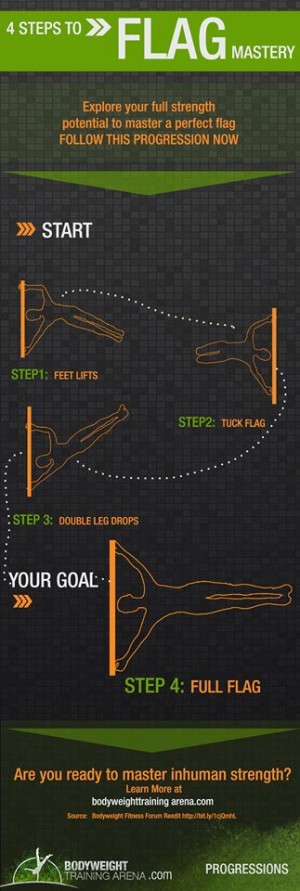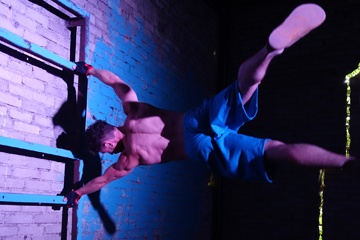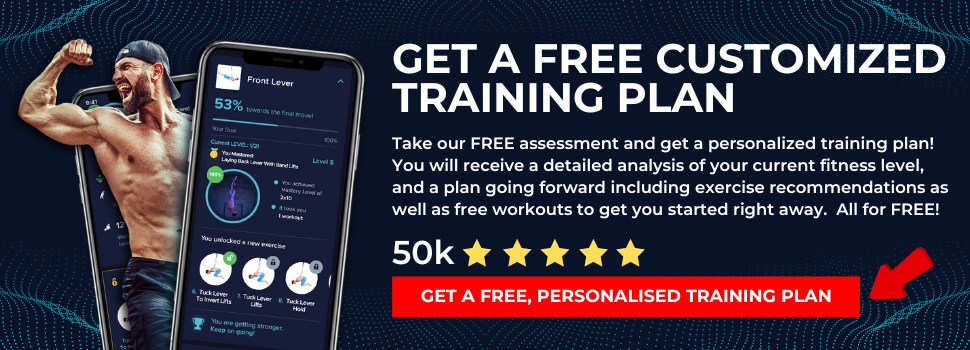Welcome to our Human Flag Progression Guide!
Before we embark on this exhilarating journey to mastering the human flag, let me share a valuable insight drawn from years of coaching experience.
Throughout our work with diverse individuals, one recurring observation is the tendency to rush into advanced calisthenics feats like the human flag without proper preparation. While the allure of such impressive displays of strength is understandable, attempting them prematurely can lead to frustration and potential injury.
In this process, we commonly encounter two scenarios:
- Struggling with advanced movements beyond one’s current capabilities, risking injury or stagnation in progress.
- Following generic progression plans that overlook individual needs, strengths, and limitations, hindering optimal growth.
As we delve into the world of calisthenics and set our sights on conquering the human flag, it’s paramount to acknowledge that each person’s journey will unfold uniquely. Some progressions may prove too challenging, while others may not provide sufficient stimulus for development.
To navigate this effectively:
- Prioritize safety and injury prevention to ensure a sustainable training journey.
- Tailor your approach to address individual strengths, weaknesses, and progression rates.
Historically, we categorized exercises into beginner, intermediate, or advanced levels. However, we’ve come to realize that this approach often falls short in providing personalized guidance.
That’s why we’ve developed The Movement Athlete Academy – a comprehensive, personalized, and adaptive training program designed to meet your specific needs and goals. Through a combination of cutting-edge technology and personalized coaching, we guide you towards mastering the human flag safely and effectively.
If you’re intrigued by this personalized approach and eager to embark on your human flag journey, I encourage you to take our FREE assessment. Say farewell to guesswork and injury risks – trust me, it’s a transformative experience.
Let’s talk Human Flag
The human flag is a challenging bodyweight exercise that requires intense strength, balance, technique, mobility, and flexibility. This article will walk you through the steps of performing the human flag with tips and progressions to help make it easier.
If you’re ready for an intense challenge, read on!
What is the human flag?🤔
The human flag is one of the most sought-after calisthenics moves where you hold your body parallel to the ground by balancing on your arms. Your legs should be straight and locked out, with toes pointed back towards your head, while the upper arm pulls hard and the lower arm pushes. The human flag is a unique calisthenics skill since it constitutes both pushing and pulling motion at the same time.
The human flag requirement
If you are just beginning your journey on becoming an expert in this exercise, it’s recommended that you start by mastering the calisthenics fundamentals before moving on to more advanced training such as the flag. The whole point of the fundamentals is to get a strong level of foundation of strength, muscles, endurance, mobility, and skills. Many people make the mistake of rushing into learning these higher-level skills. Although it is impossible, it’s more efficient, faster, safer, and more enjoyable to learn calisthenics skills with first having the basics covered.
If you need help with your fundamentals, you can train them with The Movement Athlete and use this guide for informational purposes for now.
Now let’s get into the specifics.
✅Strength
In order to perform an effective human flag variation, it’s important to have strong core muscles. A strong and stable core allows the upper torso to move with ease, which is key for a powerful human flag progression sequence. Aside from that, you must be proficient with pull-ups and push-ups. It would also be better to have more advanced variations of these moves down such as one-arm assisted variations like archers. Get solid chest, shoulder, core, arms, and back muscles so you can support your own body weight.
Having also a solid single-arm dead and active hang for both arms will do wonders for your straight-arm strength and shoulder stability.
✅Technique
The simultaneous push and pull motion to hold the flag position could be very confusing for beginners. Learning at least the basic motions separately will provide a solid base for your progress then learn how to stabilize your shoulder independently.
✅Mobility & Flexibility
People don’t realize they need mobility and flexibility for such as strength-based movement. Overhead shoulder mobility and lat flexibility are a must for you to hold the flag position so shoulder dislocates and other shoulder mobility work will do wonders. (If you’ve mastered your fundamentals, you shouldn’t worry about this). Having mobile hips are also good to support the lower body in the flag.
About this Progression
The “human flag” exercise, also known simply as the “flag” is an urban variation of bodyweight training. This progression is inspired by the free-running and parkour practice sweeping many streets, towns and cities throughout the world.
The early progression already require a good amount of core strength so prepare yourself with good core exercises beforehand. The human flag also combines a pull and pushing motion with the arms. You’ve better have a good sense of muscle coordination, especially this is a food body exercise.
You can DOWNLOAD THIS HUMAN FLAG PROGRESSION HERE

HUMAN FLAG PROGRESSION
Level
Intermediate – Advanced
Goal
To master the human flag progression
Human Flag Progression Exercises List

“El eggs” of Calisthenics Movement showing the basics of a human flag
Step 1: Hanging side pull
The first exercise focuses on further improving your side core strength. If you have noticed, a proper flag hold should have squared hips facing forward. Hanging side pull trains this motion while in the vertical position to provide an easier load.
How to perform:
- Dead hang on a pull-up bar
- Depress and retract your shoulders.
- Depress deeper on one shoulder and shift the weight of your lower body to that side.
- Maintain the position for a specified time.
- Do the same for the other side.
Coaching pointers:
- Equal training for both sides
- Engage obliques to initiate lateral spine movement
- Full-body tension
- Activate your shoulders and arms to stabilize your upper body

Step 2: 45- degree hanging hold
This is the next exercise in your human flag progression to learn the basic coordination of the top arm and bottom arm activation. Remember, the bottom arm pushes while the other pulls. This upper-body sequence is combined with the motion of the previous exercise to achieve the entry to the human flag position.
How to perform:
- Hang on a support beam with one arm then hold a vertical bar with the other.
- Push the arm holding on a vertical bar.
- Engage your obliques and move your weight sidewards until your body is in a straight line at a 45-degree angle.
- Hold the position for a specified time.
Coaching pointers:
- Find the right arm distance for you where your upper arm is working just as your lower arm.
- If the hold is too intense, you can do dynamics of going into the position then lowering back. Develop more strength until you are able to hold the position.

Step 3: Flag plank
This is a human flag variation while feet are on the ground. The leg assistance offloads the exercise while you are still building strength and muscle enough to lift your body off the ground.
- Hold the vertical pole with your top hand and the other hand on the ground or a bar on the floor.
- Straighten both of your arms and extend your legs while feet together.
- Hold the position for a specified time.
Coaching pointers:
- Hips squared and full-body sidewards
- You can lift one leg to add intensity and a balancing component.
- You may also have your legs straight and placed on top of a platform until parallel to the ground to simulate the human flag.
- Try to stay light on your feet
- When one leg is lifted, you may be able to lift the other planted foot if you are strong enough.

Step 4: Straddle flag lower downs
We now incorporate a negative or eccentric phase to increase strength while parallel holds are still not yet possible. Use straddle legs instead of straight legs to lessen the load.
While it looks possible to use tuck or knees bent variation exercises for our purpose, it will not be optimal to learn the full flag properly because the tuck hold with bent legs doesn’t provide equal loading in the lateral plane.
Instead, we can use resistance bands to make the lower downs easier and feasible.
How to perform:
- Grip the pole to begin in the starting posture.
- Lift your whole body straight up jumping into a vertical position hold.
- From there, straddle your legs and slowly lower down your body to the floor while maintaining proper flag form.
- Repeat the process for reps.
Coaching pointers:
- You can use resistance bands anchored at the pole to decrease the intensity of the exercise
- Maintain proper form throughout the motion
- You can kick and use momentum to force yourself to reach the vertical position
- Full-body tension and resist your body’s tendency to fall

Step 5: Double Leg Drops
Similar to the training above, this one is done with legs together instead of straddle legs. The seemingly small change has a massive increase in intensity to the move.
How to perform:
- Grip the pole to begin in the starting position.
- Lift your whole body straight up jumping into a vertical position hold.
- From there, slowly lower down your body to the floor while maintaining proper human flag form.
- Repeat the process for reps.
Coaching pointers:
- You can use resistance bands anchored at the pole to decrease the intensity of the exercise
- Maintain proper technique throughout the motion
- You can kick and use momentum to force yourself to reach the vertical position
- Full-body tension and resist your body’s tendency to fall

Step 6: Full Flag
It’s time to complete all the steps together and hold the final human flag hold. When attempting the move, you should be confident enough with your lower downs and overall general technique.
How to perform:
- Prepare hand placement on your equipment.
- Begin pushing and pulling with the respective upper torso musculature.
- Lift your lower torso until parallel to the ground.
- Hold for a specified time.
Coaching pointers:
- Fully squared body facing forward
- Equally working arms
- Proper breathing when doing the isometric hold

